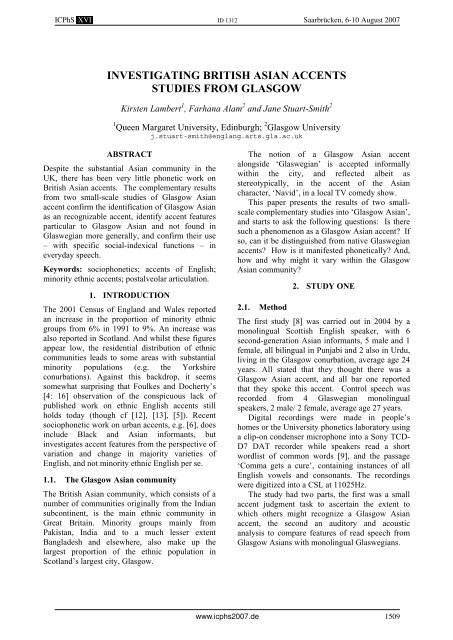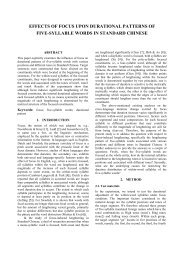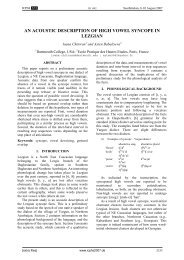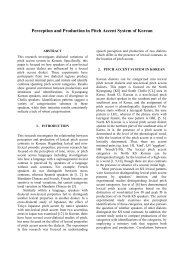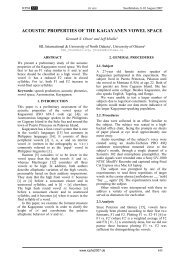full paper - ICPhS 2007
full paper - ICPhS 2007
full paper - ICPhS 2007
Create successful ePaper yourself
Turn your PDF publications into a flip-book with our unique Google optimized e-Paper software.
<strong>ICPhS</strong> XVI ID 1312 Saarbrücken, 6-10 August <strong>2007</strong><br />
INVESTIGATING BRITISH ASIAN ACCENTS<br />
STUDIES FROM GLASGOW<br />
Kirsten Lambert 1 , Farhana Alam 2 and Jane Stuart-Smith 2<br />
1 Queen Margaret University, Edinburgh; 2 Glasgow University<br />
j.stuart-smith@englang.arts.gla.ac.uk<br />
ABSTRACT<br />
Despite the substantial Asian community in the<br />
UK, there has been very little phonetic work on<br />
British Asian accents. The complementary results<br />
from two small-scale studies of Glasgow Asian<br />
accent confirm the identification of Glasgow Asian<br />
as an recognizable accent, identify accent features<br />
particular to Glasgow Asian and not found in<br />
Glaswegian more generally, and confirm their use<br />
– with specific social-indexical functions – in<br />
everyday speech.<br />
Keywords: sociophonetics; accents of English;<br />
minority ethnic accents; postalveolar articulation.<br />
1. INTRODUCTION<br />
The 2001 Census of England and Wales reported<br />
an increase in the proportion of minority ethnic<br />
groups from 6% in 1991 to 9%. An increase was<br />
also reported in Scotland. And whilst these figures<br />
appear low, the residential distribution of ethnic<br />
communities leads to some areas with substantial<br />
minority populations (e.g. the Yorkshire<br />
conurbations). Against this backdrop, it seems<br />
somewhat surprising that Foulkes and Docherty’s<br />
[4: 16] observation of the conspicuous lack of<br />
published work on ethnic English accents still<br />
holds today (though cf [12], [13], [5]). Recent<br />
sociophonetic work on urban accents, e.g. [6], does<br />
include Black and Asian informants, but<br />
investigates accent features from the perspective of<br />
variation and change in majority varieties of<br />
English, and not minority ethnic English per se.<br />
1.1. The Glasgow Asian community<br />
The British Asian community, which consists of a<br />
number of communities originally from the Indian<br />
subcontinent, is the main ethnic community in<br />
Great Britain. Minority groups mainly from<br />
Pakistan, India and to a much lesser extent<br />
Bangladesh and elsewhere, also make up the<br />
largest proportion of the ethnic population in<br />
Scotland’s largest city, Glasgow.<br />
The notion of a Glasgow Asian accent<br />
alongside ‘Glaswegian’ is accepted informally<br />
within the city, and reflected albeit as<br />
stereotypically, in the accent of the Asian<br />
character, ‘Navid’, in a local TV comedy show.<br />
This <strong>paper</strong> presents the results of two smallscale<br />
complementary studies into ‘Glasgow Asian’,<br />
and starts to ask the following questions: Is there<br />
such a phenomenon as a Glasgow Asian accent? If<br />
so, can it be distinguished from native Glaswegian<br />
accents? How is it manifested phonetically? And,<br />
how and why might it vary within the Glasgow<br />
Asian community?<br />
2.1. Method<br />
2. STUDY ONE<br />
The first study [8] was carried out in 2004 by a<br />
monolingual Scottish English speaker, with 6<br />
second-generation Asian informants, 5 male and 1<br />
female, all bilingual in Punjabi and 2 also in Urdu,<br />
living in the Glasgow conurbation, average age 24<br />
years. All stated that they thought there was a<br />
Glasgow Asian accent, and all bar one reported<br />
that they spoke this accent. Control speech was<br />
recorded from 4 Glaswegian monolingual<br />
speakers, 2 male/ 2 female, average age 27 years.<br />
Digital recordings were made in people’s<br />
homes or the University phonetics laboratory using<br />
a clip-on condenser microphone into a Sony TCD-<br />
D7 DAT recorder while speakers read a short<br />
wordlist of common words [9], and the passage<br />
‘Comma gets a cure’, containing instances of all<br />
English vowels and consonants. The recordings<br />
were digitized into a CSL at 11025Hz.<br />
The study had two parts, the first was a small<br />
accent judgment task to ascertain the extent to<br />
which others might recognize a Glasgow Asian<br />
accent, the second an auditory and acoustic<br />
analysis to compare features of read speech from<br />
Glasgow Asians with monolingual Glaswegians.<br />
www.icphs<strong>2007</strong>.de 1509
<strong>ICPhS</strong> XVI Saarbrücken, 6-10 August <strong>2007</strong><br />
2.2. Accent judgment<br />
The same section of the reading passage was<br />
extracted for two Glasgow Asian speakers and two<br />
Glaswegians, with a male and a female in both<br />
groups. Six judges were recruited, 3 were<br />
phonetically trained, and 3 were naïve listeners.<br />
All were from Scotland, and two were Asian. The<br />
judges listened to each recording once, and then<br />
completed a short questionnaire, which asked<br />
where the speaker was from, and later, whether or<br />
not they thought that the speaker might belong to<br />
an ethnic group.<br />
The results were unanimous: all 6 judges placed<br />
the speakers as Glaswegian, and also all correctly<br />
identified the two Glasgow Asian recordings as<br />
‘Asian’. The phonetically trained judges<br />
commented on retroflex articulations of /l/ and /r/,<br />
and remarks from naïve judges also seemed to<br />
refer to retroflexion in /l/.<br />
2.3. Auditory and acoustic analysis<br />
After an initial impressionistic analysis, it was<br />
decided to concentrate on four consonantal<br />
features: the realization of /l/, /b/, and /t/, and given<br />
the tendency for stylized Asian accents to use<br />
unaspirated voiceless plosives in place of voiceless<br />
aspirated plosives, the realization of word-initial<br />
/p/. Other features, such as the realization of /r/<br />
and vowel quality would also merit analysis in a<br />
future study.<br />
2.3.1. Postalveolar/retroflex /l/<br />
Punjabi shows a separate series of retroflex<br />
consonants, including /Ò/ in certain dialects [11].<br />
Retroflexion, and/or postalveolar, articulation of<br />
plosives is also a common feature of stylized Asian<br />
accents. Here, 38 instances of /l/, in a range of<br />
phonetic environments (word-initial,<br />
preconsonantal, syllable-final, postconsonantal)<br />
were auditorily transcribed for all 10 speakers.<br />
The auditory analysis identified three main<br />
groups of variants: dentalized laterals typical of<br />
Glaswegian; auditorily retracted laterals, either<br />
postalveolar, or in some cases, close to retroflex;<br />
and auditorily vocalized variants, in syllable-final<br />
position only. Figure 1 shows that while<br />
monolinguals mainly use dentalized variants<br />
(white), four of the Glasgow Asian speakers use<br />
postalveolar variants (dark); vocalized variants<br />
(light grey) occur sporadically across the two<br />
groups (χ 2 (2, N = 380) = 55.54, p = 000).<br />
This finding is consistent with Heselwood and<br />
McChrystal’s [5] study of Punjabi/English<br />
bilingual children in Bradford, where retroflexion<br />
was the most common feature found in their<br />
informants.<br />
Figure 1: Realization of /l/ as percentage of variant<br />
types, for 6 Glasgow Asian (S…) and 4 monolingual<br />
Glaswegian informants (C …). N = 380.<br />
100%<br />
80%<br />
60%<br />
40%<br />
20%<br />
0%<br />
S1 S2 S3 S4 S5 S6 C1 C2 C3 C4<br />
speakers<br />
2.3.2. Prenasalization of /b/<br />
vocalised<br />
dentalised<br />
postalveolar<br />
Heselwood and McChrystal [5] also reported<br />
instances of prenasalisation before /b/ in both<br />
Punjabi and in some English words. The wordlist<br />
contained 7 words with word-initial /b/: beat, but,<br />
bite, boot, boat, bought, baby.<br />
Table 1: Prenasalization (ms) of /b/ for Glasgow<br />
Asian speakers according to word.<br />
S1 S2 S3 S4 S5 S6<br />
beat 0 0 0 0 0 128<br />
but 90 0 0 85 64 70<br />
bite 63 36 0 58 0 129<br />
boot 0 0 0 0 0 127<br />
boat 119 90 118 96 74 90<br />
bought 125 0 128 102 78 0<br />
baby 0 0 0 0 0 0<br />
Figure 2: Spectrogram of boot from S6 with<br />
prenasalization (marked with arrow).<br />
Frequency (Hz)<br />
5000<br />
0<br />
0 0.870647<br />
Time (s)<br />
As expected, no monolingual Glaswegians<br />
showed prenasalization, but all Asian speakers<br />
showed at least one case of prenasalization, and the<br />
female speaker (S6), showed 5 instances. Table 1<br />
shows the duration of prenasalization for each<br />
speaker for each word, which is illustrated by the<br />
1510 www.icphs<strong>2007</strong>.de
<strong>ICPhS</strong> XVI Saarbrücken, 6-10 August <strong>2007</strong><br />
spectrogram of boot as spoken by the female<br />
Glasgow Asian speaker.<br />
2.3.3. Realization of final /t/<br />
Initial impressions of word-final /t/ in the speech of<br />
the Glasgow Asians were that the stops were being<br />
released with greater force than those of the<br />
Glaswegian control group. In fact, these sounds<br />
seem to resemble voiceless ejectives. See, for<br />
example, final /t/ in but in speaker S4, shown in<br />
Figure 3 (cf [10]).<br />
Frequency (Hz)<br />
Figure 3: Spectrogram of but from speaker S4 with<br />
final ejective.<br />
5000<br />
0<br />
0 0.709291<br />
Time (s)<br />
The distribution of realised, glottal, and<br />
possible ejective, plosives in the wordlist is shown<br />
in Table 2. The ‘ejective’ category is restricted to<br />
Glasgow Asian speakers, who also avoid glottal<br />
stops; the Glaswegian controls use glottal and<br />
released stops (χ 2 (2, N = 140) = 84.34, p = 000).<br />
Table 2: Realization of word-final /t/ in the wordlist<br />
for all speakers. N = 140.<br />
t / t'<br />
S1 3 0 11<br />
S2 2 0 12<br />
S3 1 0 13<br />
S4 5 0 9<br />
S5 12 0 2<br />
S6 8 0 6<br />
C1 8 6 0<br />
C2 9 5 0<br />
C3 14 0 0<br />
C4 14 0 0<br />
2.3.4. Realization of word-initial /p/<br />
Voice Onset Time was measured from release<br />
burst until the first cycle of vowel onset for the 10<br />
words with word-initial /p/ from the wordlist.<br />
Whilst unaspirated word-initial plosives are<br />
typically used in stylized Asian accents, reflecting<br />
the actual existence of two voiceless series in many<br />
Indic languages [7], a t-test revealed no statistical<br />
difference in VOT between Glasgow Asian<br />
speakers (average 54ms) and the control<br />
Glaswegians (average 52ms),<br />
3. STUDY TWO<br />
In contrast to Study One, Study Two [1] was a<br />
piece of ethnographic research carried out by a<br />
female bilingual Punjabi/Urdu/Scottish English<br />
speaking member of the Glasgow Asian<br />
community, based on social data and the auditory<br />
analysis of a specific Punjabi/Urdu language<br />
feature from spontaneous casual speech from older<br />
girls at school. The aim was to investigate the<br />
extent to which accent variation might contribute<br />
to identity construction in Asian girls.<br />
3.1. Method<br />
The framework for Study Two was that of<br />
quantitative sociolinguistics informed by<br />
ethnography (e.g. [3]), whereby linguistic variation<br />
is observed in the context of social practices<br />
through long periods of participant observation. In<br />
this case, the ethnographic fieldwork was<br />
conducted for 3 months with a group of Asian girls<br />
at a High School with a large proportion of Asian<br />
students in the south side of Glasgow. Digital<br />
recordings, using a clip-on condenser microphone<br />
into a Sony DAT TCD-D100, were made of<br />
informal interviews/conversations held by the<br />
researcher with pairs of girls in a quiet room in the<br />
school.<br />
Speech from 7 girls, all 18 years old was<br />
selected from DAT, copied onto CD, and then<br />
orthographically transcribed and analysed using<br />
Praat. First impressions suggested a range of<br />
possible features to analysis, including variation in<br />
the Scottish English monophthongs /e/ and /o/, and<br />
a tendency towards more syllable-timed rhythm. A<br />
single feature, retraction of place of articulation of<br />
the plosives /t/ and /d/ in word-initial position, was<br />
selected for analysis. Retroflex plosives exist as a<br />
separate series in Punjabi/Urdu [2], and it was<br />
hypothesized that there might be relationships<br />
between specific social practices and topics of<br />
conversation and the use of more or less retracted<br />
variants.<br />
3.2. Auditory results<br />
Figure 4 confirms the substantial presence of a<br />
retracted, postalveolar, articulation for /t/ and /d/<br />
(dark shading) in the speech of these Asian girls,<br />
alongside expected alveolar plosives (white). This<br />
is similar to the findings of Study One, where<br />
www.icphs<strong>2007</strong>.de 1511
<strong>ICPhS</strong> XVI Saarbrücken, 6-10 August <strong>2007</strong><br />
Glasgow Asian laterals could be postalveolar or<br />
dentalized.<br />
Figure 4: Realization of word-initial /t/ (n = 321) and<br />
/d/ (n = 304) in 7 Glasgow Asian 18-year old girls.<br />
100%<br />
90%<br />
80%<br />
70%<br />
60%<br />
50%<br />
40%<br />
30%<br />
20%<br />
10%<br />
0%<br />
149<br />
172<br />
t<br />
209<br />
95<br />
d<br />
alveolar<br />
postalveolar<br />
Subsequent analysis revealed that variation was<br />
linked with particular topics, for example, talking<br />
about school favoured use of alveolar variants for<br />
both /t/ and /d/. Variation was also related to social<br />
practices, such that the trendier girls who<br />
incorporated more westernised practices (such as<br />
dating and flirting) into existing Asian practices<br />
(speaking Punjabi and sometimes wearing<br />
traditional clothes), used the postalveolar variants<br />
the least.<br />
4. SUMMARY<br />
Taken together, the two studies confirm both the<br />
perceptual reality of the notion of a ‘Glasgow<br />
Asian’ accent within Glasgow, and the existence of<br />
certain phonetic features present in Glasgow Asian<br />
speech which are not found in monolinguals<br />
(postalveolar articulation, prenasalization, apparent<br />
ejectives) and which may serve particular socialindexical<br />
functions.<br />
Postalveolar articulation may continue the<br />
Punjabi/Urdu feature of retroflexion, but this is less<br />
possible for prenasalization, which possibly<br />
derives from the existence of a <strong>full</strong>y voiced series<br />
of stops in Punjabi/Urdu; ejectives are not usually<br />
reported. It seems that certain features originally<br />
derived from language interference are now being<br />
actively deployed as English accent features by<br />
second and later generation speakers, though with<br />
rather different realizations and distributions from<br />
those expected in the original language.<br />
But note that our Glasgow Asians were also<br />
recognized as Glaswegian, and this is also<br />
confirmed by their using Glaswegian features too.<br />
Furthermore, talk from the informants in Study<br />
One about Glasgow Asian referred to subvarieties<br />
existing in different parts of the city, with a<br />
particular accent for the ‘south side’ of the river,<br />
where the main Asian community resides.<br />
Interestingly, informants S3 and S5 neither lived<br />
nor socialized south of the river – they also showed<br />
no instances of postalveolar laterals.<br />
We may now begin to answer the questions<br />
posed at the outset, based on read and spontaneous<br />
speech, quasi-empirical and ethnographic methods,<br />
insider and outsider fieldworkers, accent judgment,<br />
auditory and acoustic analysis. The results confirm<br />
the notion of Glasgow Asian for Scottish speakerhearers,<br />
and in terms of the presence of specific<br />
accent features, noted here as postalveolar<br />
realization, prenasalization, and final ejectives.<br />
The features appear to occur in different kinds of<br />
speech, though we do not know to what extent<br />
speech activity may constrain or promote them.<br />
Certainly postalveolar articulations are found in<br />
read speech and frequently in spontaneous casual<br />
speech, and may vary systematically.<br />
We suggest that Glasgow Asian consists of an<br />
array of features indexical of both Glaswegian and<br />
Asian identity, but much more research is needed<br />
to substantiate this point, and indeed the features of<br />
the accent(s) themselves.<br />
5. REFERENCES<br />
[1] Alam, F. <strong>2007</strong>. Language and identity in ‘Glaswasian’<br />
adolescents. Unpublished MLitt Dissertation. University<br />
of Glasgow.<br />
[2] Bhatia, T. K. 1993. Punjabi – A Cognitive-Descriptive<br />
Grammar. London: Routledge.<br />
[3] Eckert, P. 2000. Linguistic Variation as Social Practice.<br />
Oxford: Blackwell.<br />
[4] Foulkes, P. and Docherty, G. 1999. Urban voices –<br />
overview. In Foulkes, P. and Docherty, G. (eds), Urban<br />
Voices, London: Arnold, 1-24.<br />
[5] Heselwood, B & McChrystal, L 2000. Gender, Accent<br />
Features and Voicing. Leeds Working Papers in<br />
Linguistics and Phonetics, 8: 45-69.<br />
[6] Khan, A. 2003. Reading revisited: dialect levelling within<br />
a multi-ethnic British community. Unpublished MA<br />
dissertation. University of Reading.<br />
[7] Ladefoged, P. and Maddieson, I. 1996. The Sounds of the<br />
World’s Languages. Oxford: Blackwell.<br />
[8] Lambert, K. The Asian Glaswegian accent. Unpublished<br />
Undergraduate Dissertation. University of Glasgow.<br />
[9] Rogers, H. 2000. The sounds of English. Essex: Pearson.<br />
[10] Scobbie, J. and Gordeeva, O. 2006. Phonetic<br />
conditioning of word-final ejective stops in the speech of<br />
Scottish English pre-school children. BAAP, University<br />
of Edinburgh.<br />
[11] Shackle, C. 1972. Punjabi: A complete course for<br />
beginners. New York: Hodder.<br />
[12] Wells, J. C. 1973. Jamaican Pronunciation in London.<br />
Oxford: Blackwell.<br />
[13] Wells, J. C. 1982. Accents of English. Cambridge: CUP.<br />
1512 www.icphs<strong>2007</strong>.de


